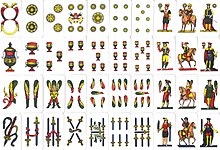Truc y flou
 Italian pack for playing Truc y flou | |
| Type | plain trick taking |
|---|---|
| Players | 6 |
Truc y flou (also Truc et fleur) is a card game from Aragon in Spain, which is played in the French Pyrenees in the Aure and Louron valleys in Hautes-Pyrénées and the Oueil valley near Luchonnais.[1] It may be compared to the games of Aluette, Brisca and Mus. A significant and enjoyable part of the game is the communication and bluffing that is allowed between partners.
History[]
Playing cards were probably introduced to France via the routes through the Pyrenees as well as through ports on the Atlantic Ocean and Mediterranean Sea. In 1825, Catalan-pattern cards appeared, being manufactured by Dessouris and bore a strange resemblance to Truc cards. Catalan Truc resisted competition from other games such as Belote, Rummy, Bridge, Tarot and Poker. Truc y Flou itself originated in Spain where it had been practised since at least the 19th century.[2]
Distribution[]
The game, which uses Spanish cards, is played in the Central Pyrenees in the département of Hautes-Pyrénées up to the slopes of the Haute-Garonne. In Haute-Pyrénées, it is played only in the valley of the Aure and in the valley of the Oueil near Luchonnais. The same cards are used in the Upper Aragon in Spain to play Guignoté and the Basques play Mus with them.[2]
Players[]
It is played by six players, divided into two teams of three. Each team has a captain who sits in the middle, collects information from his team mates and directs the tactics.[1]
Equipment[]
Cards[]
The game uses a pack of 48 Spanish or Catalonian cards from which the Eights and Nines are removed, leaving 40 cards, divided into 4 suits: Swords (Epée or Aspade); Batons (Bâton or Bastou); Coins (Soleil or Aurous); and Cups (Coupe or Copas).[2]
Card ranking and values[]
From the highest to lowest:
- Swords - 2 points
- Batons - 1 point
- Manille or 7 of Swords ;
- Manille or 7 of Coins ;
- Treys (3s) ;
- Deuces (2s) ;
- Pouts: Coins and Cups - 0 points
Counters[]
There are 25 points in the game, which are tallied using counters, typically dried Tarbais beans, and a jeton, called an espintou, which is worth 13 points to mark roughly the half-way stage and facilitate counting.[2]
Rules[]
Each player must quickly identify the stronger cards (trick-taking cards) and communicate them discreetly to captain of each team, who will decide on the strategy to follow. He will then make a discreet announcement using signals e.g. an embit (embide = "you may go")
Signals[]
During the game, players use coded signals to communicate information to their team mates about their cards. The following signals are used:[1]
- 2 points - raise your eyebrows
- 1 point - wink an eye
- 7 of Swords - twitch lips to the right
- 7 of Coins - twitch lips to the left
- Treys - lower lip under upper
- Deuces - puff of breath
References[]
- ^ a b c La confrérie du Truc Y Flou en Vallée d’Aure at www.cadeilhan-trachere.com. Retrieved 15 May 2020.
- ^ a b c d Jeux de Cartes at cadeilhan-trachere.com. Retrieved 17 May 2020.
External links[]
- French card games
- Spanish deck card games
- Plain-trick games
- Six-player card games
- Occitania
- Card games involving signalling